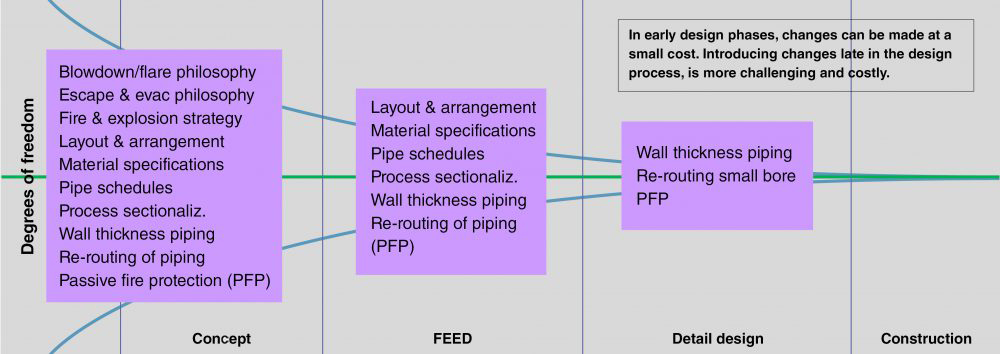
Segment Blowdown
Depressurization
We use our well known depressurisation tool VessFire to perform vessel survivability analysis. For more information or license for VessFire, visit the “Products” tab or click here.
Depressurization is a highly complex physical phenomenon. It demands insight into a variety of subjects to correctly analyze and interpret results from calculations, and insight and experience are also necessary to recommend solutions to issues that may be identified.
Petrell has conducted hundreds of blowdown (depressurization) analyses using VessFire, both fire cases and cold blowdown cases. VessFire complies fully with the analysis method suggested in API 521. Blowdown analysis is the main task in segment survivability analysis and process system fire integrity analysis.
VessFire allows for playing with different materials, specifications, wall thicknesses, passive fire protection, blowdown valve arrangement and orifice diameters, in order to explore ways to improve blowdown system performance and meet acceptance criteria. Acceptance criteria can be those suggested in Guidelines or they can be defined by the project/client.
Vessel Survivability
Many clients are concerned about the integrity of vessels. Experience shows that vessels normally show better performance characteristics than pipes in fire situations. It is important to note, that it is not sufficient to analyse only the vessel. The pressure relief valves and blowdown valves of a process segment are normally attached to the vessel. This means that also the contents of all pipe-work upstream and downstream of the vessel will have to escape through the vessel’s blowdown arrangement. Thus, addressing vessel survivability must include the entire segment of which the vessel is a part. Most, if not all of the segment’s pipework will also be exposed to fire loads if the vessel is exposed to a jet fire. It is the background or global heat load that causes the temperature of the inventory to increase, resulting in increased pressure. The entire segment acts as a heat exchanger; this is why the pipework must be included, with material properties, wall thickness, diameter and possible insulation.
The illustration below addresses the well-known fact that the price tag of change increases dramatically the later into project execution the change is implemented. This concerns not at least fire integrity and process safety, just think of the cost of the flare system, ESD valves, and passive fire protection of piping, vessels and structural steel and supports. The earlier these issues are addressed the better the solution will be; in the early phases including the concept phase the options are plentiful – changes can be made at literally no cost. VessFire is a unique tool in this respect as it all comes together – process sectionalisation and segment sizes, ESD, blowdown and flare philosophy, layout & arrangement (in terms of fire loads, fire scenarios and fire exposure), material selections, wall thicknesses of vessels and pipework. If you start to think about fire integrity in detailed design, you will probably realise that it is too late. The answer is too often ‘passive fire protection’, and this will add engineering costs, fabrication costs, installation cost, and inspection and maintenance cost.
We see too often that projects start to study fire integrity and process safety too late. These issues should be addressed in the concept and FEED stages, when it is still possible to change and modify solutions without adding too much cost.
Fire Loads
Standard fire loads as for instance given in NORSOK S-001 or the Scandpower procedure can be applied. However, it should be observed that plant/installation geometry and topology as well as equipment layout and arrangement may influence the fire scenario. Fire scenario should be assessed thoroughly in order to define applicable fire loads. The background (global) heat load is of particular importance.
Low temperature studies
During depressurization the temperature will fall, and sometimes the fluid gets really cold, exposing the pipework, flanges etc to low temperatures. Temperatures may get so low that the system can face rupture due to embrittlement. Low temperature situations are of special interest for blowdown lines and other pressure relieving lines.
For oil and gas platforms operating on the norwegian continental shelf, NORSOK standards apply. See NORSOK P-001 Ch.4.3.2 on requirements for minimum design temperature.
Petrell ensures your plant’s safety from brittle fractures during depressurization. We offer low temperature analysis for your plant, including vessels, process equipment, pipework and valves.

Due to the Joule-Thomson effect when expanding a gas, the process segment in general and the tailpipe downstream the orifice in particular, may experience very low temperatures.
The low temperature shall be calculated and compared with the material quality in the system.
Scandpower Guidelines for protection of Pressurised Systems Exposed to Fire, Section 5.9
Do you want more information?
Please send us an enquiry, and we’ll be in touch as soon as possible. We always look forward to hear from you!








